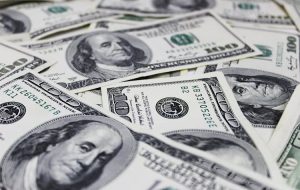US Dollar marginally weaker as markets await key US employment data
[ad_1] Share: The US Dollar is slightly weaker against its major rivals to begin the week. The US Dollar Index stays above 101.50 after posting gains last week. US jobs report and other high-tier data releases this week could drive USD performance. The US Dollar stays marginally weaker on Monday after posting strong

[ad_1]
- The US Dollar is slightly weaker against its major rivals to begin the week.
- The US Dollar Index stays above 101.50 after posting gains last week.
- US jobs report and other high-tier data releases this week could drive USD performance.
The US Dollar stays marginally weaker on Monday after posting strong gains against major rivals last week. Nevertheless, the USD Index – which tracks the USD’s valuation against a basket of six major currencies – has stayed within a narrow consolidation channel above 101.50.
The USD gathered strength in the second half of last week as data from the US revealed that the economy continued to grow at a healthy rate in the second quarter, while labor market conditions remained tight. As the US Bureau of Economic Analysis’ monthly report showed that the Personal Consumption Expenditures (PCE) Price Index rose at a softer pace than anticipated, the USD rally lost steam ahead of the weekend.
The US economic docket will feature important labor market-related data releases this week, which could drive the USD’s valuation. On Tuesday, the US Bureau of Labor Statistics will publish JOLTS Job Openings figures ahead of the ADP private sector employment on Wednesday and Nonfarm Payrolls on Friday. The ISM Manufacturing and Services PMI surveys will also be watched closely by investors this week.
Daily digest market movers: US Dollar holds steady on Monday
- Wall Street’s main indexes opened moderately higher on Monday. As of writing, three main indexes, Dow Jones Industrial Average, Nasdaq Composite and S&P 500, were up between 0.1% and 0.15%.
- The ISM reported on Monday that the Chicago PMI improved to 42.8 in July from 41.5 in June.
- The Federal Reserve Bank of Dallas’ Texas Manufacturing Survey revealed that the headline Manufacturing Business Index edged higher to -20 in July from -23.2 in June.
- Inflation in the US, as measured by the change in Personal Consumption Expenditures (PCE) Price Index, fell to 3% on a yearly basis in June from 3.8% in May, the US Bureau of Economic Analysis reported on Friday. This reading came in below the market expectation of 3.1%.
- Core PCE Price Index, the Federal Reserve’s preferred gauge of inflation, arrived at 4.1% on a yearly basis, down from 4.6% in May and below the market forecast of 4.2%. Further details of the publication revealed that Personal Income and Personal Spending increased 0.3% and 0.5% on a monthly basis, respectively.
- The real Gross Domestic Product (GDP) of the US expanded at an annualized rate of 2.4% in the second quarter, the US Bureau of Economic Analysis’ (BEA) first estimate showed on Thursday. This reading followed the 2% growth recorded in the first quarter and surpassed the market expectation of 1.8% by a wide margin.
- According to the CME Group FedWatch Tool, markets are pricing in a 20% probability of a 25-basis-point Federal Reserve (Fed) rate hike in September.
- The benchmark 10-year US Treasury bond yields stays relatively calm at around 4% on Monday.
- In an interview with CBS over the weekend, Minneapolis Federal Reserve Bank President Neel Kashkari said that he was not sure whether the Fed was done raising rates. Commenting on the jobs markets, Kashkari noted that it would not surprise him to see the unemployment rate tick up slightly.
- The Fed raised its policy rate by 25 basis points (bps) to the range of 5.25%-5.5% following the July policy meeting as expected. In the post-meeting press conference, Fed Chairman Jerome Powell refrained from confirming another rate hike this year and said that every policy meeting will be live. “If we see inflation coming down credibly, we can move down to a neutral level and then below neutral at some point,” Powell told reporters, noting that the policy was already restrictive.
Technical analysis: US Dollar Index stabilizes above 20-day SMA
The US Dollar Index (DXY) closed above the 20-day Simple Moving Average (SMA), currently located at 101.30, on Friday after testing that level in the early American session. In the meantime, the Relative Strength Index (RSI) indicator on the daily chart stays near 50 on Monday, reflecting a lack of directional momentum
On the upside, 102.00 (static level, psychological level) aligns as initial resistance before 102.50 (50-day SMA, 100-day SMA). A daily close above the latter could attract buyers and pave the way for an extended uptrend toward 103.00 (psychological level, static level).
Looking south, 101.30 (20-day SMA) stays intact as key support level. If DXY drops below that level and starts using it as resistance, 101.00 (psychological level, static level) could be seen as interim support ahead of 100.50 (static level) and 100.00 (psychological level).
US Dollar FAQs
The US Dollar (USD) is the official currency of the United States of America, and the ‘de facto’ currency of a significant number of other countries where it is found in circulation alongside local notes. It is the most heavily traded currency in the world, accounting for over 88% of all global foreign exchange turnover, or an average of $6.6 trillion in transactions per day, according to data from 2022.
Following the second world war, the USD took over from the British Pound as the world’s reserve currency. For most of its history, the US Dollar was backed by Gold, until the Bretton Woods Agreement in 1971 when the Gold Standard went away.
The most important single factor impacting on the value of the US Dollar is monetary policy, which is shaped by the Federal Reserve (Fed). The Fed has two mandates: to achieve price stability (control inflation) and foster full employment. Its primary tool to achieve these two goals is by adjusting interest rates.
When prices are rising too quickly and inflation is above the Fed’s 2% target, the Fed will raise rates, which helps the USD value. When inflation falls below 2% or the Unemployment Rate is too high, the Fed may lower interest rates, which weighs on the Greenback.
In extreme situations, the Federal Reserve can also print more Dollars and enact quantitative easing (QE). QE is the process by which the Fed substantially increases the flow of credit in a stuck financial system.
It is a non-standard policy measure used when credit has dried up because banks will not lend to each other (out of the fear of counterparty default). It is a last resort when simply lowering interest rates is unlikely to achieve the necessary result. It was the Fed’s weapon of choice to combat the credit crunch that occurred during the Great Financial Crisis in 2008. It involves the Fed printing more Dollars and using them to buy US government bonds predominantly from financial institutions. QE usually leads to a weaker US Dollar.
Quantitative tightening (QT) is the reverse process whereby the Federal Reserve stops buying bonds from financial institutions and does not reinvest the principal from the bonds it holds maturing in new purchases. It is usually positive for the US Dollar.
.
[ad_2]
لینک منبع : هوشمند نیوز
 آموزش مجازی مدیریت عالی حرفه ای کسب و کار Post DBA آموزش مجازی مدیریت عالی حرفه ای کسب و کار Post DBA+ مدرک معتبر قابل ترجمه رسمی با مهر دادگستری و وزارت امور خارجه |  آموزش مجازی مدیریت عالی و حرفه ای کسب و کار DBA آموزش مجازی مدیریت عالی و حرفه ای کسب و کار DBA+ مدرک معتبر قابل ترجمه رسمی با مهر دادگستری و وزارت امور خارجه |  آموزش مجازی مدیریت کسب و کار MBA آموزش مجازی مدیریت کسب و کار MBA+ مدرک معتبر قابل ترجمه رسمی با مهر دادگستری و وزارت امور خارجه |
 مدیریت حرفه ای کافی شاپ |  حقوقدان خبره |  سرآشپز حرفه ای |
 آموزش مجازی تعمیرات موبایل آموزش مجازی تعمیرات موبایل |  آموزش مجازی ICDL مهارت های رایانه کار درجه یک و دو |  آموزش مجازی کارشناس معاملات املاک_ مشاور املاک آموزش مجازی کارشناس معاملات املاک_ مشاور املاک |
برچسب ها :Await ، Data ، Dollar ، DollarIndex ، Employment ، Key ، macroeconomics ، marginally ، Markets ، seo ، Technical analysis ، UnitedStates ، Weaker
- نظرات ارسال شده توسط شما، پس از تایید توسط مدیران سایت منتشر خواهد شد.
- نظراتی که حاوی تهمت یا افترا باشد منتشر نخواهد شد.
- نظراتی که به غیر از زبان فارسی یا غیر مرتبط با خبر باشد منتشر نخواهد شد.





ارسال نظر شما
مجموع نظرات : 0 در انتظار بررسی : 0 انتشار یافته : ۰